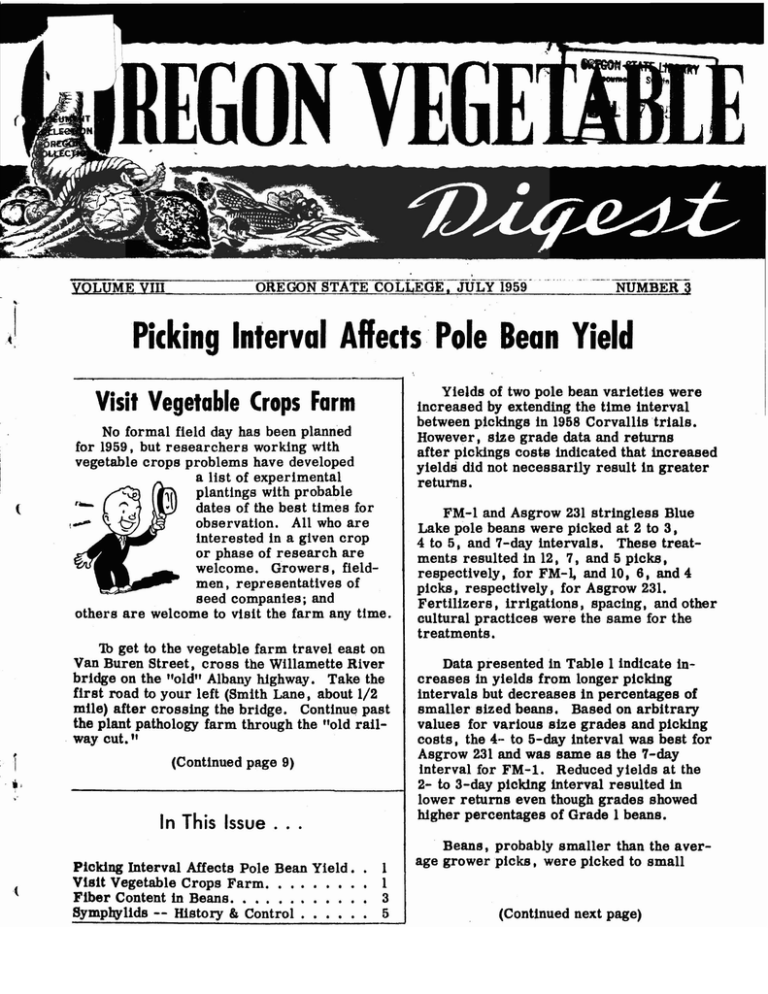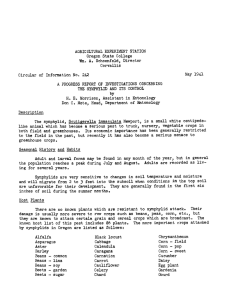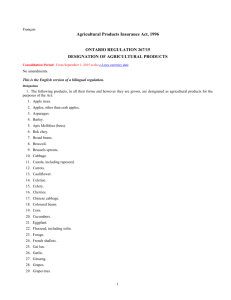Document 11260887
advertisement

YOLUMEVIn OREGON STA'tECOt"L1:Gt-;;rULYI9S-9- NUMBER_a • ) Picking Interval Affects' Pole Bean Yield Visit Vegetable Crops Farm No formal field day has been planned for 1959, but researchers working with vegetable crops problems have developed a list of experimental plantings with probable dates of the best Umes for ,-t;;:T) ~ observation. All who are interested in a given crop or phase of research are welcome. Growers, fleld­ men, representatives of seed companies; and others are welcome to visit the farm any time. !-- ( .. 1b get to the vegetable farm travel east on Van Buren Street, cross the Willamette River bridge on the "old" Albany highway. Take the first road to your left (Smith Lane, about 1/2 mUe) after crossing the bridge. Continue past the plant pathology farm through the "old raU­ way cut." i ,. i (Continued page 9) ' In This Issue ... ( Picking Interval Affects Pole Bean Visit Vegetable Crops Farm. • . . Fiber Content in Beans. • • . . . . Sympbylids -- History & Control . Yield.. . . • •• . • . .• . . • .. 1 1 3 5 Yields of two pole bean varieties were increased by extending the time interval between pickings in 1958 Corvallis trials. However, size grade data and returns after pickings costs indicated that increased yields did not necessarily result in greater returns. FM-l and Asgrow 231 stringless Blue Lake pole beans were picked at 2 to 3, 4 to 5, and 7-day intervals. These treat­ ments resulted in 12, 7, and 5 picks, respectively, for FM-l, and 10, 6, and 4 picks, respectively, for Asgrow 231. Fertilizers, irrigations, spacing, and other cultural practices were the same for the treatments. Data presented in Table 1 indicate in.. . creases in yields from longer picking intervals but decreases in percentages of smaller sized beans. Based on arbitrary values for various size grades and picking costs, the 4- to 5-day interval was best for Asgrow 231 and was same as the 7-day interval for FM -1. Reduced yields at the 2- to 3-day picking interval resulted in lower returns even though grades showed higher percentages of Grade 1 beans. . Beans, probably smaller than the aver­ age grower picks , were picked to small (Continued next page) 2 ( Pole Bean Yield ••• (Continued from 'page 1) sizes in all treatments. This contributed to the "good" grades of the 7-day interval treatment. Results are interesting because of varietal response to different picking intervals. Asgrow 231 tends to have a greater concentration of maturity than FM-I and a shorter picking interval may be of more importance than in a variety such as FM-I. Results probably will vary from year to year since temperatures during picking season affect growth, and consequently will determine the picking interval needed for obtaining best grades. Temperature data during July and August were presented in the article on blossom drop of pole beans in the Oregon Vegetable Digest, Vol. VITI, No.1 Results of a picking interval test in 1957 were reported in Vol. VI, No.4, of the Oregon Vegetable Digest. Table 1. Effects of Picking Interval on Yield of Pole Beans Corvaliis, 1958 231 FM-1 and A lett % in size Slrades Gross Picking Return after 3 4 2 return picking cost cost -. c FM-1 Interval Tons per acre 1 (1) 2 to 3 days (2) 4 to 5 days (3) 7 days 8.73 9.60 11.34 77.8 64.9 42.5 15.7 5.4 25.0 8.1 33.5 19.0 1.1 $1328. 2.0 ·1440. 1553. 5.0 $569. 624. 7.40 8.88 9.36 72.2 60.0 42.3 17.2 8.6 25.1 10.5 26.3 20.4 2.0 $1089. 1284. 1229. 11.0 $481. 577. 608. '737. $759. 816. 816. Asgrow 231 Interval (1) 2 to 3 days (2) 4 to 5 days (3) 7 days 4.4 $608. 707. 621. Arbitrary Values: $170 per ton for Grade 1; $150 per ton for Grade 2; $95 per ton for Grade 3; $65 per ton for Grade 4; $65 per ton for picking cost. --H. J. Mack Department of Horticulture A ( A A Oregon's Vegetable Digest is published four times a year by the Agricultural Experiment Station, Oregon State College, Corvallis. F. E. Price, Director. Address correspondence to the author concerned or to the Department of Horticulture. Materi;il 111ay he rcprintcd providing- 110 cndorsenH.'nt of a C01l1111Crcial product is stated or ilnplied. l"lleage credit ()rcg-oJ1 Statc (·ol1t'g-c. silnplify tcchnical ternlinolog-y, trade nallU'S of products or cquipnlcnt S0111ctillles will be uscd. No cnc10rsclncnt of products naJlled is intcnded nor is criticisnl itnplied of products not Incntioned. 'ro 3 ( Fiber (ontent in Beans Quality of snap beans is influenced by size and maturity of pods, storage conditions, defects t varietal characteristics J and weather factors. Development of seed in pods of varieties grown commercially in Oregon has not been a limiting factor for quality in meet­ ing minimum standards set up by the Food and Drug Administration. Under normal conditions J fiber content of Oregon beans has been of minor consideration. Research results in 1958 indicated many varieties and, selections from experimental plots at Corvallis were extremely high in fiber content. Other investigators showed higher fiber content can result from high temperatures and low humidities during maturation of bean pods. Weather during the 1958 bean season was favorable for high fiber in beans. . « On evaluation of a large number of Blue Lake type bush selections t utrue" bush selections and bush varieties mechanically harvested. fiber content was found to be lower in most Blue Lake type bush bean selections than in oommercial bush varieties. A repre­ sentative number of these fiber determinations Is shown in Table 1 t including three sizes of beans and both oanned and frozen packs. The sizes 5-6 beans of tttrue" bush varieties) P·rocessor and Harvester. are "sub­ standard" in quality in the canned beans because of high fiber. Tolerance is set at 0.15%. Fiber content of the 5-6 size of Processor variety in the frozen. pack is much lower. When comparing selections and varieties. increase in fiber with size was much greater in the "true" bush varieties. Table 1. Percentage of Fiber in Canned and Frozen Bush Beans Canned beans Frozen.beans Selection sizes sizes or variety 3-4 5-6 1-2 3-4 5-6 1-2 .0330 .0226 .• 0165 816 (BL) .0447 .0692 .0298 .0329 .0233 .0294 .1036 .0328 .0536 412 (BL) .0294 .0442 .0720 .0237 836 (BL) .0258 .0478 .0325 Tenderwhite .1375 .0231 .0158 .1065 .' 0421 Processor .0413 .0245 .1750 .0759 .1172 .1001 Harvester .0595 .1725 .0895 .0173 .0403 (Continued page 4) 4 Fiber Conlenl in Beans ••• (Continued from page 3) Fiber in beans, when determined by the FDA method, is the alkali-indigestible material remaining after digestion brought about by boiling 1 N NaOH for five minutes, grinding in a malted milk machine and washing through a 30-mesh screen. Recent experiments show the blanching temperature to which beans are exposed prior to canning and freezing processes has a marked effect on alkali-indigestible material or fiber. 0 Table 2 shows treatment of beans at blanching temperature of 150 0 -170 F. results in maximum alkali-indigestible material. At 2000 F. alkali-indigestible material is reduced approximately 9ne half. This piece of evidence is substantiated by data in Table 1. Fiber content was lower in practical~ all instances in frozen beans than in canned beans. Canned beans received a blanch of 1 78 F. for 1 1/2 minutes while frozen beans were blanched in , steam at 212 0 F. for 1 1/2 minutes. " Table 2. Fiber Percentages Resulting from Specific Blanching Temperatures *Blanchin2 temDerature (degrees F.) Pergent fillers 130 140 150 .0273 .0296 .0671 .0595 .0625 .0436 .0399 .0323 160 170 « 180 190 200 *Blanching temperatures for 5 mi'nutes. In view of these experiments. processors should include fiber determination of the finished product among objective determinations conducted in their quality control program. While the fiber content is usually not a limiting factor for bean quality in Oregon, exceptions such as weather factors and over-maturity should not be overlooked. W. A. Sistrunk Department of Food and Dairy Technology • W. A. Frazier Department of Horticulture 11etJeta&e 1ttJte ••• The 1959 revision of the Oregon Insect Control Handbook is now available. Insect control measures against vegetable, tree fruit, nut ornamental, household, livestock, and forage crop pests have been reviewed and brought up to date for the 1959 season. This handy reference can be purchased from the Co-op Bookstore, Memorial Union BUilding,. Corvallis, Oregon. t 5 Symphylids -- History and Control Since symphylids are considered as Oregon's number one solI pest. a brief revtew of them and of the efforts made to control them may be of interest. Symphylids are small, white, terrestrial, centipede-like animals belonging to the Class Symphyla. Adults have .12 pairs of legs, while insects ha~e six pairs and centipedes have 15 pairs. First recognized about the middle of the 19th century, symphylids were regarded as zoological curiosities in the evolutionary development of true insects. There are now two families composed of 15 genera and about 110 species. ,,' c Until recently I only one species I Scutigerella Immacplata (Newport) or the garden centipede. was· considered of economic importance. This common name is a misnomer because it is not a centipede nor are its activities limited to gardens. In 1957 J Edwards (University of Wisconsin) in his graduate thesis, listed 11 species, mostly European t as plant feeders. In 1958, Savos (OBC) in a graduate thesis J suspected Symphylellopsis alba Mich. of damaging Oregon crops. . In 1905. Woodworth first reported that symphylids were damaging ,asparagus in California. Since then, many workers from the United States and Europe have observed them damaging crops in greenhouses, field8. and gardens. Thomps·on'(OSC)'first reported symphylid damage in Oregon in 1934. Subsequent checking of records at Oregon State College indicates they were probably an unrecognized problem as early as 1910. By 1937 J they became a serious threat to commercial vegetable plantings in Oregon and a research project was organized to study their biology and control. Originally, the locus of symphylid infestation was in isolated sections of the Willamette Valley, Oregon, and size of infested areas seldom exceeded one fourth of an acre. Today t. symphylids are found in most of the arable sections of the state and five to six acres of heavily infested soil are not uncommon. Many such areas may exist in one large field. It has been estimated that symphylids cause over one million dollars damage annually in Oregon. In addition to vegetables, symphylids are now known to be destructive to strawberries J cane fruits, ornamental J nursery and greenhouse plantings, and such field crops as mint and hops. Plant injury is of three general types: (1) destruction of germinating seeds; (2) damage to root hairs J roots J and stems J causing plant stunting; and (3) pitting of under­ ground portions of such crops as carrots, turnip~, and beets. Several factors are associated with the steady and rapid development of symphylids as an economic problem. Farmers frequently assumed unproductive areas in a field resulted from nitrogen deficiencies and often used heavy applications of manure to remedy the condition. Although this practice has been largely discontinued, it generally tended to in­ crease the size of symphylid infested areas. Subsequent studies have shown that heavily manured soil will support four to five times more symphylids than unmanured soil. Probably the most significant factor in the increased symphylid problem seems to be related to expansion in the use of sprinkler irrigation. This practice provides favorable (Continued on page 6) 6 Symphylids ••• (Continued from page 5) moisture conditions for symphylid feeding and development throughout the growing season. After World War IT, some sections of the Willamette Valley of Oregon abandoned the practice of dry land farming and began growing sprinkler irrigated crops such as vegetables and mint. Within four to five years after this change, these farms had a serious symphylid problem. Another factor that should be recognized is that food habits of symphylids appear to be changing. Although symphylids are probably native to Oregon and other sections of the country J they are constantly becominp; pests of new host plants. For example, at the Oregon State Forest Nursery. near Corvallis, symphylid idamage in 1937 was limited to black walnut, Caragana, and Russian Olive seedlings. Conlfer seedlings were never attacked. Today. symphylids cause serious injury to most of the conifer seedlings produced at thi,s nursery. J . f In 1937, symphylld control studies were undertaken in Oregon without much knowledge of the biology. seasonal history J and" habits of the pest. Unpromising results were obtained with coal tar products J arsenicals, botanicals, and poison baits. Although commercial fertilizers sometimes aided plants to outgrow symphylid attack, they did not control the pest. Probably the most significant information obtained from these early trials was that symphylids were extremely chemotropic and would avoid chemically treated areas until the chemical was neutralized or expelled from the soil. Also. the usual criteria used in evaluating control .,measures (population counts t plant v:igor I yields, etc.) could not be directly applied to symphylids. During the period 1939-1942, small plot trials with weed gun applications of chlor.opicrin and ethide showed th~e fumigants would kill symphylids. These trials demonstrated the need for well prepared seed'beds for good kills. Small plots were found to be af little value in demonstrating symphylid control because reinfestation often occurred within several weeks. It was also learned, but not fully appreciated, that seasonal vertical migratory habits of symphylids would play an important role in timing of applications of soil fumigants. In 1946, commercial equipment for applying soil fumigants, such as D-D Mixture and ethylene dibromide, was made available in Oregon. Initial te8t8- with D-D Mixture (May 13) were disappointing. Although many symphylids were killed, no measure of control was evident when beans were planted in the treated area June 3. It was evident that symphylids had migrated upward from the subsoil after the fumigant was expelled from the solI. I In the same year J after crops were removed from the field, both D-D Mixture and ethylene dibromide gave excellent symphylid control. This could not be determined until the following season. Later tests with D- D Mixture applied to large fields during the period from July through August were satisfactory. Today, 11 years later, Borne of these fields have not been seriously reinfested with symphylids. These tests served to illustrate the importance of timing of application of Boil fumigants for symphylid control. Some attempts were made (1946-1947) by commer.~ial applicators to interest growers in feasibility of soil fumigation for symphylid control. Although some acres were fumigated, growers in most instances were not receptive to the idea. This was associated with the high cost of materials, the need for specialized equipment, and lack of understanding by com­ mercial operators of the intricate relationship of timing and 'seedbed preparation for good control. (Continued on page 7) 7 ( Symphylids • • •(Continued from page 6) During the period from 1945 to 1953 J considerable effort was .spent in testing the many chlorinated hydrocarbon insecticides which had appeared on the market. In some fields. aldrin, dieldrin, and heptachlor were qUite satisfactory for symphylid control and results could be repeated from year to year. However t in most instances, the inseoticides per- . formed in an erratic manner. Attempts to determine causes of these inconsistencies were not fruitful. It was learned, however, that chemical transformations occurred when the insecticides were mixed with the soil. (Bollen, Kiigemagi, OSC) In 1953, Howitt (Washington) demonstrated that parathion, used as a soil treatment several days before planting, re.sulted in excellent symphylid control. The following season, extensive tests with par.atbion showed it gave adequate initial crop protection for such crops as beans and corn. However t it would not prevent serious symphylid feeding later in the season. It is evident that after use of parathion in a field for five successive seasons, growers may still be confronted with a symphylid problem. In some instances. it has not adequately protected root crops such as beets and carrots from serious damage. Since 1953, interest has been renewed in us~ of soil fumigants for Symphylid control. Good results have been obtained with such materials as Vapam, Fumazone, Nemagon, Telane. D-D Mixture. ethylene dibromide. and Picfume. Chemical companies have developed improved equipment for application of these fumigants. 4 Preparatory steps. required for good nematode control with soil fumigants are needed to control symphylids. o 'Bannon , speaking before the Shell Nematology Workshop at Yuma, Arizona, in 1957 listed five essential steps for satisfactory nematode control. ·They are: (1) elimination of crop residue, (2) a finely prepared.seedbed, (3) breaking up of hard spots in plow sole areas, (4) soil moisture and te;mperatures t and (5) the "sealing in" of the fumigant after application. other important requirements for symphylid control are: (1) application of materials below level of symphylid concentration, (2) timing, and (3) adequate equipment . .1. Depth of application In contrast to nematodes, symphylids may be considered as ."movable targets" which move away from fumigants and other chemicals. If the fumigant is applied above the level where symphylids are concentrated, the pests move into the subsoil until the fumigant is expelled and then return to feed on plants. Since symphylids are constantly in a state of vertical migration (daily as well as seasonal), the area of concentration can be determined only by examination of soil immediately before fumigant application. t. 2. Timing r' In Oregon, symphylids tend to move deep into the soil during fall, winter, and early spring months. They concentrate in upper soil (top nine inches) during June and reach their peak of concentration during July and August. If good weather conditions prevail. this (Continued on page 8) 8 Symphylids • • • (Continued from page 7) concentration period may extend into mid-September. Best results are obtained when soil fumigants are applied during this period. Soil temperatures are generally suited for optimum performance of fumigants during July and August and seedbeds· are more easily prepared. If optimum soil moisture conditions are lacking, they can be cor­ rected by use of sprinkler irrigation systems. 3. Adequate equipment For nematode control J good results are obtained with shank type applicators with tines spaced 12 or more inches apart. Since symphyllds are "movable targets t U tines should not be spaced more than eight to nine inches apart--even closer when Vapam is used. Since diffusion patterns differ according to fumigant and soil type J a blade type applicator has been preferred for symphylid control. With this equipment, a continuous sheet of fumigant ts applied beneath the soil at the desired depth, leaVing little room for symphlids to escape. Probably the most notable "break through" in equipment was introduced by Phil Beilke of Brooks. Oregon, in 1958. This was the use of a V-blade applicator mounted on a crawler tractor. The unit has sufficient power to apply fumigants' at desired depth and does not have the handicap of poor traction so common with wheel tractors. The blade cleans itself readily of plant debris and may make adequate control possible with lower dosages of fumigant. Use of this equipment 'should eliminate much guess work in symphylid control and could possibly extend timing of treatments from June through September. In study of soil pest control, close interdepartment team work has existed at. Oregon State College between the Departments of Bacteriology J Entomology, Plant Pathology, Agricultural Chemistry, Agricultural Engineering, Horticulture, and Food Technology • Field and laboratory studies with Telane, D-D Mixture, ethylene dibromide. and Nemagon have indicated only relatively small, and in most cases temporary, depressive and stimulative effects on microbial activities in soil. Since timing for symphylid control calls for fumigants to be applied the year before crops are grown, there has been no need to collect chemical residue data on various crops. Incomplete studies have indicated flavor differences will not be a problemo In 1958, the Departments of Entomology, Plant Pathology, and Agricultural Engineering, cooperatively conducted a series of field demonstrations. Several of these trials have been established in mint fields in an attempt to control both symphylids and nematodes which were competing for the same crop. Growers were invited to these special field days to observe the application of various fumigants with the best eqUipment available and in well prepared seedbedsfj> Interest in the use of Boil fumigants has increased as a result of these demonstrations~ More demonstrations in other areas are needed if the symphylid problem is to be solved. Efforts of this kind require the cooperative'interest of chemical companies, food pro­ cessors, and extension and research workers. H. E. Morrison Department of Entomology • A• 9 Visit Vegetable Crops Farm ••• (Continued from page 1) Peas (early July) Virus resistant lines, inoluding Dr. Barton' 8 Geneva f New York lIIlterials. Bush Beans (about July 20) Virus and root rot resistance Time of planting Row· spacing Growth regulators Boron tolerance (in cooperation with Soils Dept. ) Derivatives of Blue Lake backcross progr.am Wax lines Pole Beans (about August 5) Virus and root rot resistance Growth regulators Irrigation levels and nitrogen rates (in cooperation with the Departments of .80118 and Agricultural Engineering) Breeding lines -- growth habit J yield, quality, round and flat pod types Wax lines Table Beets (~bout August 20) Boron f~rtil1zers (in cooperation with Soils Dept.) ~ Sweet Corn Weed control other Crops Rhubarb Seedlings for improved color; any time in summer Melons Early cantaloupe and watermelons (about September 5) Tom~toes Earliness. quality, yield, crack-resistance (about September 10) Lima Beans Small, round, green-cotyledon lines (about September 10) .. Carrots Varieties (a fewF 1 hybrids), fertilizers. and time of planting--lnternal browning problem (about October 15) Members of the Department of Entomology are also conducting research at the vegetable farm on the problem of slugs (bush beans) J onion maggots J and residual soil insecticides. Extensive research on symphylid control with a number of test crops can be observed. Various weed control experiments may also be seen at the research farm • .....






